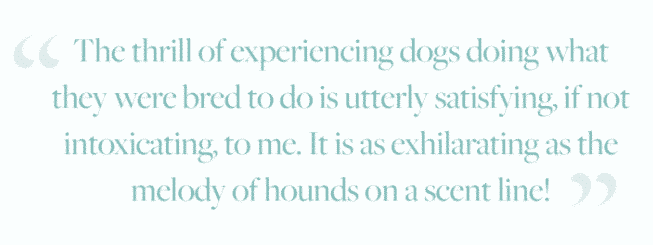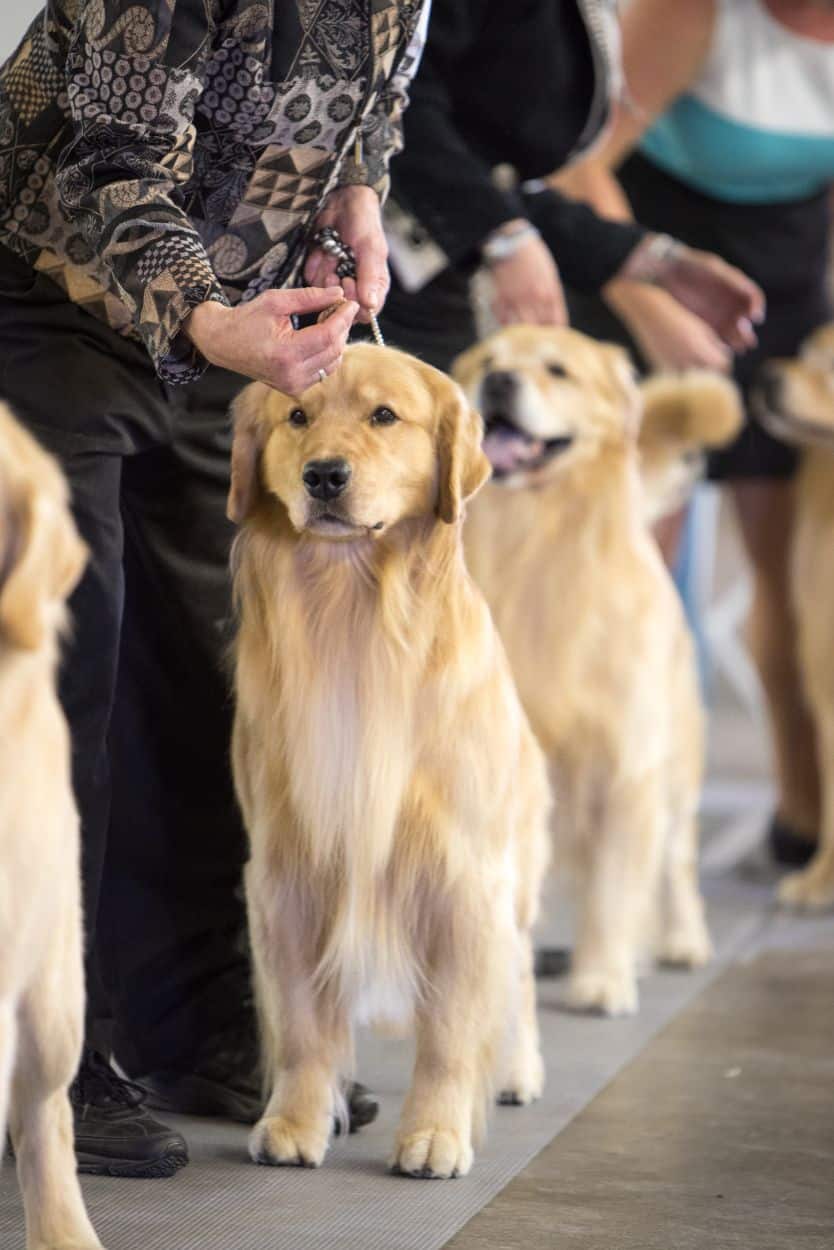This series is a discussion about the natural tension that exists between how we view show dogs, field/working dogs, and dual-purpose (show and work/field) dogs. The dog grouping last discussed was the Working Group. This month, we will begin to explore the AKC Sporting Group. How does the evolved morphological form relate to past and/or current function? How and why is it that some breeds have developed different types for field/work and show? What are the actual or perceived similarities and differences between the purebred show dog and field/work dog? What have breeders done to breed dogs that can do the job for which they were intended, if it still exists, and if not, what simulations exist that are as close to the original intent
as possible?
Before standards were written for the breeds in the Sporting Group that we recognize today, dogs were already being used and selectively bred to perform certain work. Multiple factors impacted the development of these breeds and their continued evolution, including geography, climate and terrain, culture and customs, as well as the type of work to be performed. Within this Group, we find breeds that traditionally served as pointers, retrievers, flushers, and water dogs. In many cases, the original purpose of the breed no longer exists or has been supplanted by technology and equipment, enabling man to do the dogs’ work faster and more efficiently at times. Still, there are dedicated breeders who continue to breed quality specimens that demonstrate the individual breed’s working abilities where the actual work, or a simulation, exists.
That many breeds in the Sporting Group exist in almost three different genres is a given. Within this Group, we find those that are bred solely for competition purposes, be it show or field trial, and then those that are passively bred for the purposes that each breed was developed; and that is, to accompany and assist a hunter in a day’s hunt of various species of game fowl. It is among this last sort that one finds those Sporting dogs that are generally non-competitive. Where competition has become an overriding impetus to breed—be it show or field trial—a divergence from non-competitive type has emerged. Some would say that this divergence in types, physically and/or mentally, has been to the detriment of the breed(s) as a whole, with neither displaying the collective moderate traits relied upon by the sportsman/sportswoman hunter. Where breeders have made a very conscientious effort to preserve moderation in breed traits of competitive specimens, the breed has been well-served. There are several specific Sporting breeds that come to my mind, each displaying no difference between the general hunter’s dog, the competitive show dog or the competitive field trial dog. Then there are those few Sporting breeds where competition of any type is secondary to the breeds’ purpose as a general game fowl hunter’s dog. These particular breeds are not often found in competitive venues, but are seen in certain regions of the country where they are popular as game fowl gundogs. This is even more so the case in the European countries where many breeds, Sporting and otherwise, exist mainly for hunting or working, with nary a competitive event within
its scope.
This writer has been very fortunate to have observed a variety of the Sporting breeds doing what they were bred to do in natural surroundings, with average game bird hunters enjoying a morning or afternoon of shooting over their faithful canine partners—only to enjoy the spoils of a day’s outing at the dinner table or preparing their take for freezer storage and future consumption. There’s nothing quite like spending time on a South Georgia hunting plantation watching an English Setter ranging to find scent and then set (point) in a frozen position upon a covey of quail—only to be released to slowly creep up on the birds and set them in flight, ready for the hunter’s gun. Seeing a Brittany range an Iowa or Nebraska field and lock up on point after scenting a pheasant is a sight to behold. Sensational were the mornings when I’d pass various waterfowl congregation areas on my way to work in southern Delaware, only to hear a rifle shot and see a flash of a dead grass-colored dog plunge into the water to retrieve a downed duck; a Chesapeake Bay Retriever doing what it was bred to do. I have sat patiently in a blind next to a work colleague and his Labrador Retriever, waiting for a duck to come within range and for a successful shot to be fired—only to see his Lab shine with life as she went out to retrieve her duck for her master. These hobby hunters were not, apparently, concerned with style, yet all had dogs that did their jobs efficiently and suited the hunters’ interest in a specific type of hunting companion. The thrill of experiencing dogs doing what they were bred to do is utterly satisfying, if not intoxicating, to me. It is as exhilarating as the melody of hounds on a scent line!
The Fédération Cynologique Internationale (FCI) has divided this grouping of gundogs—all found in the AKC Sporting Group—mainly into two distinct Groups: Pointers (FCI Group 7); and Retrievers (FCI Group 8). Within FCI Groups 7 and 8 are various AKC-recognized breeds, listed below, as well as FCI-only-recognized breeds. Those breeds whose names appear in italics are not subject to a working trial in order to obtain an International Show Championship (C.I.E.) Within FCI Group 7, Section 1, are the Continental Pointing Dogs, which includes the German Shorthaired Pointer, German Wirehaired Pointer, Weimaraner, Vizsla (shorthaired), Wirehaired Vizsla, Brittany, Wirehaired Pointing Griffon, Spinone Italiano, and the Bracco Italiano. The Bracco is, currently, in the AKC Miscellaneous Group. Within Group 7, Section 2, comprised of the British and Irish Setters and Pointers, are the Pointer (English), English Setter, Gordon Setter, Irish Setter, and the Irish Red and White Setter. FCI Group 8 consists of three sections: Section 1, Retrievers; Section 2, Flushing Dogs; and Section 3, Water Dogs. Within Group 8, Section 1, Retrievers, are the Chesapeake Bay Retriever, Curly-Coated Retriever, Flat-Coated Retriever, Golden Retriever, Labrador Retriever, and the Nova Scotia Duck Tolling Retriever. Comprising Group 8, Section 2, Flushing Dogs, are the Clumber Spaniel, Cocker Spaniel (English), Cocker Spaniel (American), English Springer Spaniel, Field Spaniel, Sussex Spaniel, Welsh Springer Spaniel, and the Nederlandse Kooikerhondje. Group 8, Section 3, Water Dogs, is comprised of the American Water Spaniel, Barbet (French Water Dog), Irish Water Spaniel, and the Lagotto Romagnolo.

The Setter breeds that are the subject of this installment in the series obtained their general name of “setter” due to the habit of moving into a still and crouching stance when game was scented. The game birds of interest avoid potential predators by concealing themselves, rather than by taking wing. The game was, and still is, generally, pheasant, quail, grouse or other game birds that tend to spend time hiding on the ground. Before the widespread use of the wheel lock (later, flint lock and rifling guns), these types of dogs were used for the purpose of trapping game birds by flinging a net over the birds. Prior to the use of nets was the use of falcons to swoop down on the game bird, set in flight by the dog upon command of the hunter. Some literature indicates that a setter-like dog was developed as early as the 15th century in the UK.
According to writings by Johannes Caius, the progenitor setter-type dogs (setting spaniels) were thought to have originated in France and made their way to the UK in the 1570s. By the 1600s, setters were found throughout Britain, although it was not until later, in the early-to-mid-1800s, that the different types—and, later, distinct Setter breeds—were developed.
Changes occurred in sporting affairs following the end of the First World War, especially those concerning the method of shooting and the role of the gundog. World War II accelerated the changes, and “walking up” game was superseded by “driving” and craft in the field through marksmanship. The gundog soon became the canine of choice for recovering dead or wounded birds. This is not to say that the Setters go without use in today’s bird sport. One often finds Setters (and Pointers) accompanied on quail hunts by some breeds of Retrievers, fresh from the wagon to fetch the downed bird after the Setter has demonstrated its endurance and acuity by scouring the fields in search of
sitting birds.
The modern English Setter was developed, in large part, first by Edward Laverack in the mid-1800s and, then using Laverack’s dogs, by Purcell Llewellin in the mid-1800s to early 1900s. In fact, English Setters at the time were often referred to as Laverack or Llewellin Setters. Edward Laverack wrote in The Setter (1872), “…the Setter is but an improved Spaniel.” During that time, it was concluded that the Setter was, in large part, derived from an old Land Spaniel.
As recently as the mid-1980s, this author’s then employer, a veterinarian and gundog enthusiast who maintained a kennel of these dogs, referred to them as “Llewellin Setters.”
The English Setter is the smallest and most moderate of the Setter breeds today. Field-type and show-type English Setters appear almost as separate breeds while still being of the same origins. The field-type English Setter is a smaller, lighter-boned, and much lighter-feathered dog with a tighter skin over a head that is not as pronounced in its planes from any direction. Its hindquarter angulation is not nearly as pronounced as the show-type English Setter and its tail carriage is at almost 12 o’clock when on point. Photographs of national specialty winners from the early to mid-1930s show a closer approximation to that of today’s field-type
English Setter.
Occasionally, English Setters become dual champions (bench and field) and the parent club offers Hunt Tests with its National Specialty Show scheduling. The parent club also maintains two awards for those English Setters that are used
as gundogs.
Some of the early setter-types made their way to Ireland, and by the 1790s the Irish were beginning to develop their own breed of Setter. By the 1840s, setters in Ireland were of either the red type or the red and white type, or they were white with red patches or lemon-colored. By 1850, the breed was being referred to in literature as the “Irish Setter.” Originally made up in a heavier style (though not as heavy as the English Setter or what would become the Gordon Setter), the Irish Setter began to acquire a lighter, racier look by the earlier 1860s. Its red coloration became the norm and, by 1886, the Irish Red Setter Club was formed in Dublin. This “look” eventually came to the US where it was bred on, and people became enamored of the breed as a companion rather than a superb grouse dog. Even during the years between the two World Wars, there were a few active Irish Setter gundog kennels that proved the breed’s mettle. However, the 1930s saw the breed turn favor from a gundog to a companion and show dog. By the 1940s, Field and Stream magazine was reporting that the breed was disappearing from the field. Proponents of the working gundog imported some dogs from overseas as well as crossed existing gundog stock with red and white English Setters whose offspring were registered in the Field Dog Stud Book (FDSB). By virtue of registration in the FDSB, the AKC allowed the offspring to be registered in the AKC stud book as well. In 1975, the Irish Setter Club of America petitioned the AKC to stop reciprocal registration between the FDSB and AKC, and the request was fulfilled. It was not until later in the second half of the 20th century, following the breed’s steep decline in popularity, that some interest once again turned to the breed as a sportsmen’s gundog.
The US parent club offers yearly Irish Setter-only field trials in which field champion points and amateur field champion points can be earned as well as a walking field trial and a walking hunt test in the open and amateur formats. In 2019, the parent club awarded four dual-titled (bench champion and hunt test) dogs their hunt test titles (junior, senior, or master hunter). For the previous year, one Irish Setter was awarded a dual title of bench champion and junior hunter.
The dogs that are used exclusively for field trial work appear heavier in body and much lighter in feathering volume and length than the show specimens, with the tail being held more upright when on point than the carriage seen in the show ring. That the breed has taken two directions, show and competitive field, is regrettable. The efforts of those who continue to strive to breed the dual-purpose Irish Setter, field and bench, are commendable. Interestingly, the FCI standard for the Irish Setter calls for a smaller size than the AKC standard: 23-26 ½” for dogs, 21 ½ -24 ½” for bitches (FCI); versus 27″ for dogs, 25″ for bitches (AKC).
The Irish Red and White Setter existed as a strain as early as the mid-18th century. It was sometimes referred to as the Rossmore Setter, named for the family in Ireland that developed this strain of setters that was of red and white coloration. This strain was preserved by the Rossmore family into the 20th century and was well-known for their gundog abilities with ground-hiding gamebirds. The breed declined greatly in popularity and, upon return from World War I, an Irish clergyman attempted to revive the breed through the use of existing stock. In the mid-1940s, a breed club was formed, but numbers did not increase significantly. In the 1970s, a united effort was initiated in Ireland to revive the breed. Numbers began to slowly increase and, by 1981, the breed club had been renamed at least twice. By the 1980s and late ‘90s, several revisions to the breed standard occurred that included color and pattern definition as well as penalizing for trimming.
On first glance, the Irish Red and White Setter not only has much less furnishings all over than does the Irish Setter, it is also slightly lower in height range (AKC standard) and does not have the all-too-common sweeping rear angulation of the Irish Setter. The heads are also a bit different in substance, skin, and shape. The Irish Red and White Setter, though a fairly recent (1980s) re-introduction to the US, has maintained, to a large extent, its original type and style. The parent club in the US has described the breed’s hunting style in order to familiarize those who judge AKC field events. It has also described a grooming style that forbids the shaving, scissoring, and shaping of the breed’s coat.
The heaviest of the Setter breeds is the Gordon Setter. Prior to being accepted by the Kennel Club (UK) in 1924 as the “Gordon Setter,” these dogs were known in 1872 by the KC as a breed called the Black and Tan Setter. They were found in many kennels throughout Scotland and the north of England, but are most closely associated in name with Alexander Gordon, the 4th Duke of Gordon (1743-1827). The Duke maintained of kennel of setters at Gordon Castle in the very north of Scotland, and these dogs were black and tan as well as tri-colored. The Duke interbred his setters with other kennels’ dogs to obtain the wide-ranging gundog employed to locate the red grouse and ptarmigan found in those northern areas.
Gordon Setters made their way to the US, being brought over by George Blunt and Daniel Webster in 1842. The parent club offers a yearly national championship field trial and, in 2018, began offering a national walking gundog championship. Besides these events, the club also offers field awards to Gundog of the Year, Gundog (Retrieve) of the Year, Derby Dog of the Year (for those that are not puppies, but not yet finished hunting dogs), and Puppy of the Year. In addition to these awards, any Gordon Setter earning an AKC conformation title, plus an obedience/tracking/agility title, and a field title, is awarded the “Beauty, Brains,
Birdsense Award.”
To their credit, there are Gordon Setter enthusiasts throughout the country who hunt and show the same dogs, and there have been dual champions in the breed. One does find that the field-only Gordon tends to be not quite as heavy in substance as the show Gordon, but definitely more so than the English Setter. The emphasis on a show coat in show Gordons does not appear to be as excessive as with the other Setter breeds. Morphologically, the breed evolved into a consistent type and structure without having pervasive excesses that have occurred in so many other breeds.
What has caused the demise of Setters used as hobby gundogs and the emphasis placed on the show-type dog with its excessive (for the field) feathering? Is it the gradual change in the interests of the population as it moved from rural to urban and suburban settings? Do people no longer learn at a young age to enjoy hunting with gundogs? Do people still experience and enjoy meals with different types of animal protein than that which is commonly available commercially? Are many areas of the country so built-up that game fowl no longer have habitat? Have types of land use permits supplanted the ability of hunters to shoot over their dogs? This writer does not have the answers, but would enjoy learning what you think.
I’ll look forward to your commentary and questions on this article, as well as the ones that follow in this series. Feel free to send your comments to [email protected] or to me at [email protected].











